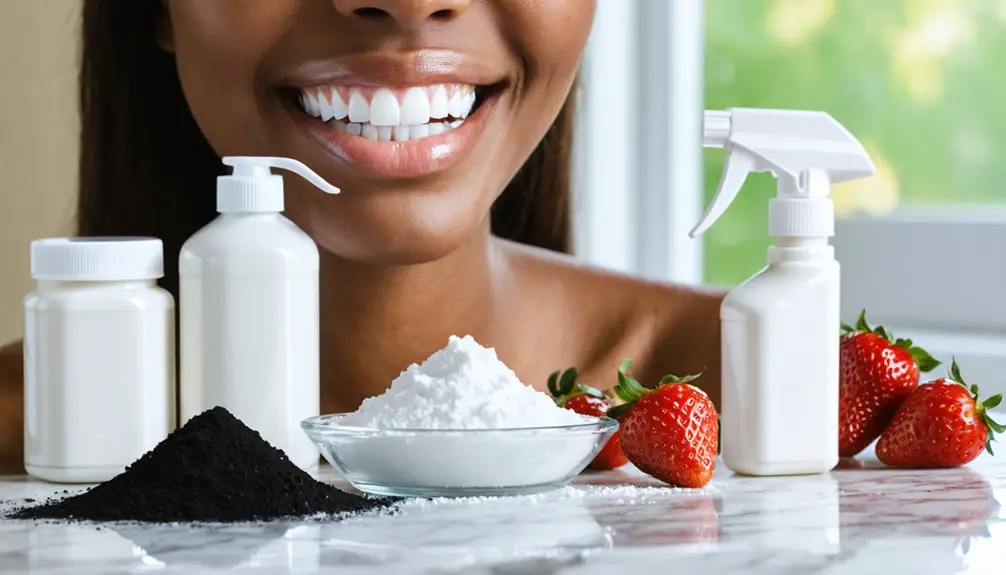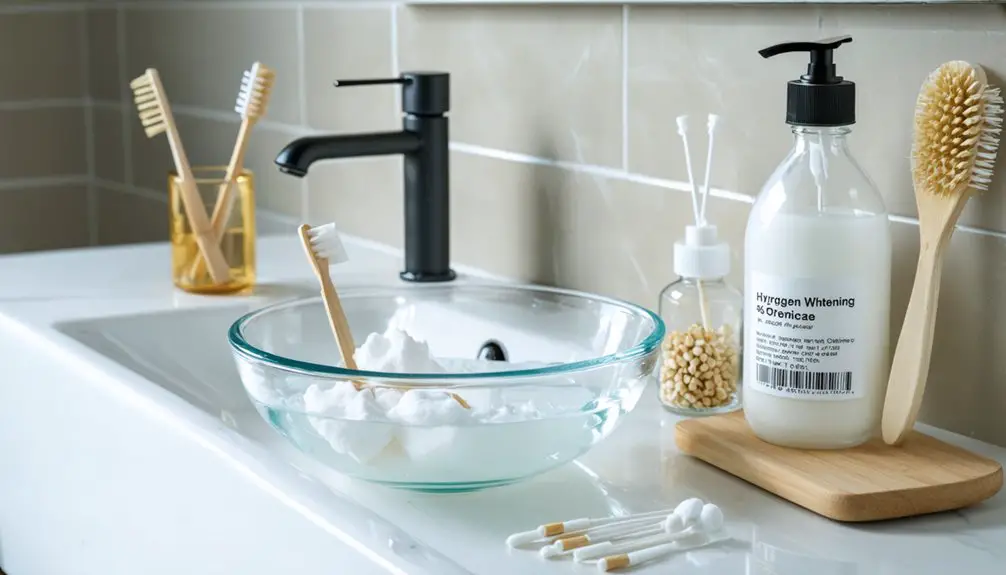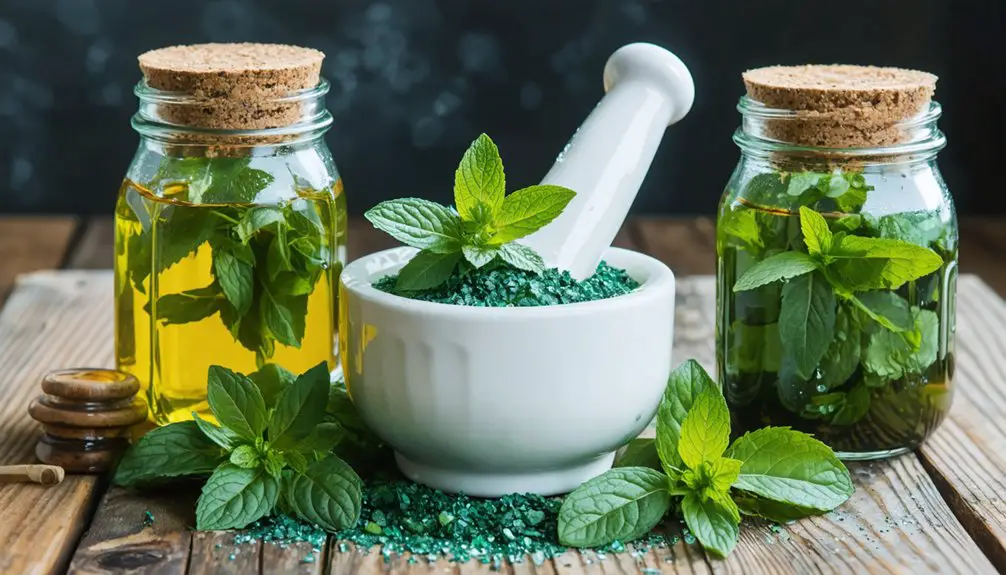You can achieve professional-level teeth whitening results at home through several proven methods. Professional-grade LED kits offer dramatic improvements of 4-5 shades, while peroxide-based strips provide gentler 1-2 shade changes. Custom-fit trays guarantee precise application of stronger whitening gels, and specialized toothpaste-rinse combinations enhance daily maintenance. Natural remedies like baking soda and crunchy fruits offer mild whitening effects. Understanding each method’s strengths will help you select the most suitable approach.
Key Takeaways
- LED whitening kits provide professional-grade results at home, combining light technology with peroxide gels for 4-5 shade improvements.
- Custom-fit whitening trays ensure precise gel application and faster results while preventing gum irritation during treatment.
- Peroxide-based whitening strips can lighten teeth 1-2 shades within two weeks when used daily for 30-60 minutes.
- Use whitening toothpaste and rinse combinations twice daily with hydrogen peroxide for gradual but effective stain removal.
- Natural remedies like baking soda and crunchy fruits can help remove surface stains while maintaining good oral health.
Professional-Grade LED Whitening Kits
While professional teeth whitening at a dental office can be costly, professional-grade LED whitening kits offer an effective at-home alternative. These kits combine LED technology with peroxide-based gels to accelerate the whitening process, achieving noticeable results in fewer treatments. The LED light activates the whitening agents, breaking down stains more efficiently than gels alone. The LaserGlow Professional Whitening machine represents a prime example of this technology at an accessible price point.
You’ll find most professional kits include custom-fit mouthpieces and precise timing controls to guarantee even application. The best options contain 10-35% hydrogen peroxide concentration, along with ingredients like potassium nitrate to minimize sensitivity. Users appreciate having control over their treatment as they can adjust whitening sessions around their schedules.
For maximum whitening effectiveness, look for devices with wavelengths between 400-500 nm. When following manufacturer instructions carefully, you can achieve 4-5 shade improvements, particularly in reducing yellow tones.
Peroxide-Based Whitening Strips
Two primary peroxide compounds power modern teeth whitening strips: hydrogen peroxide and carbamide peroxide.
These compounds penetrate your enamel and dentin to break down stain-causing chromogens through oxidation, effectively lightening your teeth by one to two shades within 7-14 days. The strips use advanced seal technology to maintain close contact with teeth during treatment.
For ideal results, application methods require daily use for 30-60 minutes. You’ll need to follow manufacturer guidelines precisely and avoid eating or drinking during treatment.
While these strips are generally safe, essential safety precautions include monitoring for tooth sensitivity and gum irritation. If you experience significant discomfort, discontinue use immediately and consult your dentist.
These strips work best on surface stains from coffee, wine, or tobacco, though they can also address deeper, age-related discoloration with extended use. These over-the-counter options provide a more affordable alternative to professional treatments.
Regular maintenance treatments help preserve your whitening results.
Custom-Fit Whitening Trays
Because professional-grade whitening demands precise application, custom-fit whitening trays offer superior results through their personalized molding process.
You’ll achieve more consistent whitening as these trays guarantee uniform gel distribution and prevent leakage onto your gums. The custom-molded design ensures a perfect fit for every individual’s unique teeth structure. The snug fit eliminates pressure points and gaps common in generic options.
Custom trays allow you to use higher-strength whitening gel safely at home while minimizing tooth sensitivity and gum irritation. Professional whitening supervision ensures optimal safety and effectiveness throughout your treatment.
You’ll notice faster, more dramatic results compared to over-the-counter alternatives. The reusable design provides excellent value, as you’ll only need periodic gel refills to maintain your brighter smile.
Plus, you can whiten on your schedule, wearing the comfortable trays while reading or watching TV, making the process both convenient and effective.
Whitening Toothpaste and Rinse Combinations
Since achieving ideal whitening results requires a strategic approach, combining specialized toothpaste and rinses can considerably enhance your teeth’s brightness.
You’ll maximize whitening effectiveness by using products containing hydrogen peroxide, while ingredients like nano hydroxyapatite and fluoride guarantee proper enamel protection during the process.
Apply a pea-sized amount of whitening toothpaste twice daily, followed by a peroxide-based rinse.
For optimal whitening results, apply whitening toothpaste twice daily using a pea-sized amount and finish with peroxide-based mouthwash.
Look for formulations that include baking soda or calcium carbonate for gentle stain removal.
Products like Colgate Optic White have demonstrated visible results within four weeks of consistent use.
If you have sensitive teeth, avoid products with high alcohol content or acidic compounds. Instead, choose options containing glycerin for hydration and fluoride for strengthening.
For safer whitening, select toothpastes that are Made Safe certified to ensure they’re free from harmful chemicals.
This combination approach delivers superior results compared to using either product alone, especially when you maintain consistent daily use according to manufacturer guidelines.
Safe Natural Remedies for Teeth Whitening
While chemical whitening products dominate the market, natural remedies offer gentler alternatives for brightening your smile. Among these options, baking soda benefits stand out, as it effectively removes surface stains without severely damaging enamel when used in moderation.
You can safely incorporate it into your oral care routine by mixing it with your regular toothpaste. Oil pulling therapy shows potential benefits for overall oral hygiene maintenance.
Citrus fruits like strawberries contain natural acids that can help whiten teeth, though you’ll need to use them cautiously to avoid enamel damage.
For a safer approach, try crunchy fruits and vegetables like apples and carrots, which naturally clean teeth while stimulating protective saliva production. A balanced diet plan supports long-term dental health and helps maintain natural tooth whiteness.
Remember to reduce your consumption of staining substances like coffee and red wine to maintain results.
If you’re considering activated charcoal, proceed with caution as research remains inconclusive about its safety and effectiveness.
Frequently Asked Questions
Can Whitening Treatments Damage Existing Dental Work Like Crowns or Veneers?
With more strength than a steel fortress, your dental materials won’t be damaged by whitening products. While they can’t whiten crowns or veneers, these treatments won’t harm your existing dental work.
How Long Should I Wait to Whiten Teeth After Getting Dental Fillings?
You’ll need to wait 7-14 days after getting composite fillings before starting any whitening treatments. This whitening timeline guarantees proper dental filling care and prevents potential damage to your restorations.
Is It Safe to Whiten Teeth While Pregnant or Breastfeeding?
Like avoiding raw fish during pregnancy, you shouldn’t whiten your teeth while pregnant or breastfeeding. Whitening safety isn’t confirmed, and pregnancy considerations suggest waiting until after these periods to protect your baby.
Should I Avoid Certain Foods and Drinks During the Whitening Process?
You’ll need to avoid dark, acidic, and staining food choices and drink options during whitening. Stick to white or clear items, and avoid coffee, tea, wine, and artificially colored products.
How Can I Prevent Tooth Sensitivity Before Starting a Whitening Treatment?
Use desensitizing toothpaste two weeks before whitening for sensitivity reduction, avoid acidic foods, protect your enamel with hydroxyapatite products, and opt for lower-concentration whitening agents with custom-fitted trays.
References
- https://www.goodhousekeeping.com/health-products/g28723133/best-at-home-teeth-whitening-products/
- https://kaufmandentistry.com/2025/04/10/which-at-home-whitening-treatments-are-worth-it/
- https://cheslynhaydental.co.uk/do-these-8-popular-home-teeth-whitening-methods-work/
- https://nhdentistrybeverlyhills.com/press/6-of-the-best-teeth-whitening-kits-in-the-drugstore/
- https://lanedds.com/which-teeth-whitening-technique-lasts-longest/
- https://pmc.ncbi.nlm.nih.gov/articles/PMC3466022/
- https://www.salvatoredental.com/dental-services/blog/do-home-teeth-whitening-kits-work-which-ones-are-best
- https://www.laserglowspa.com/products/professional-led-teeth-whitening-machine
- https://www.matthewsfamilydentistry.com/blog/do-at-home-teeth-whitening-kits-work/
- https://g-p-dental.com/best-teeth-whitening-kits-in-2025-safe-option/



